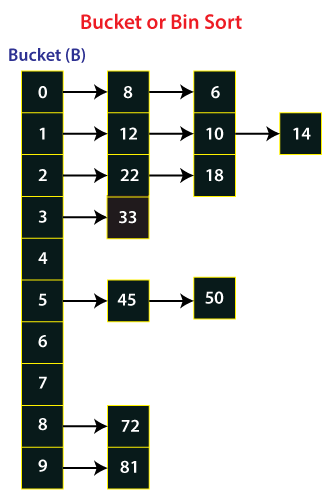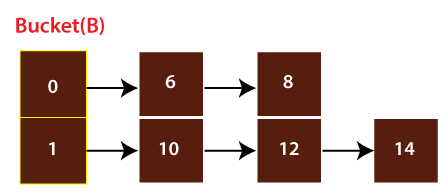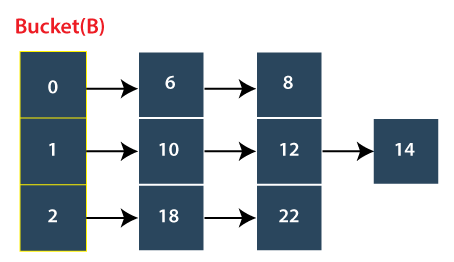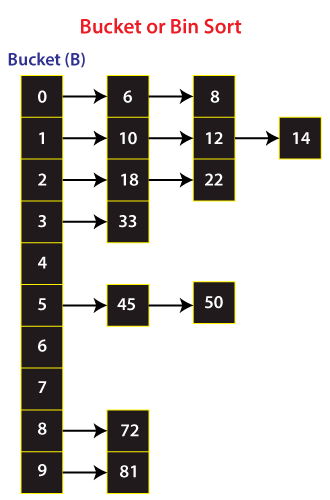Bucket Sort in Java
Bucket sort is a sorting technique in which elements are first uniformly divided into several groups called buckets. After that, elements are sorted by any sorting algorithm, and finally, it gathered the elements in a sorted manner. In this section, we will learn how bucket sort works, its algorithm, complexity, example, and its implementation in a Java program.
Bucket Sort
Bucket sort or bin sort is a sorting algorithm that works by distributing the elements into a number of buckets, homogenously. Each bucket is then sorted individually. In order to sort the bucket, we use the sort() method of the Arrays class. It is usually used to sort floating-point numbers.
The basic idea to perform the bucket sort is:
- Partition the range into a fixed number of buckets.
- Toss each element into its appropriate bucket.
- Sort each bucket individually using insertion sort.
- Concatenate all the sorted buckets.
Pros
- It is asymptotically fast because of uniform distribution.
- It reduces the number of comparisons.
- It is fast in comparison to bubble sort.
Cons
- It is not an in-place sorting because we need some extra space to sort the buckets.
- It may or may not be the stable sorting algorithm.
- It is not useful if we have large array because it increases the cost.
Let’s see the algorithm.
Algorithm
Bucket Sort(A[])
- Let B[0….n-1] be a new array
- n=length[A]
- for i=0 to n-1
- make B[i] an empty list
- for i=1 to n
- do insert A[i] into list B[n a[i]]
- for i=0 to n-1
- do sort list B[i] with insertion-sort
- Concatenate lists B[0], B[1],..……, B[n-1] together in order
Complexity
| Time Complexity | |
|---|---|
| Worst Case | O(n2) |
| Best Case | O(n+k) |
| Average Case | O(n+k) |
Bucket Sort Example
Sort the following array in ascending order by using the bucket sort.
arr[]=22, 45, 12, 8, 10, 6, 72, 81, 33, 18, 50, 14
Total number of elements in the given array (N) = 12
Max element in array = 81
Min element in array = 6

We need 10 buckets to sort the array. Suppose, these 10 buckets are represented as B. After that, we need to find a divider that will be used to put the elements in the bucket. In order to determine the divider, we use the following formula:

Let’s put the values in the above formula, we get:

Hence, bucket = 10, divider = 9
Let’s put the element arr[i] in the correct bucket, we will use the following formula:

Let’s see how it works by putting elements in the buckets. We will start from the first index.
For i=0:

We will insert the zeroth element (22) in the 2nd bucket and increment the array index (i) by 1.
For i=1:

We will insert the first element (45) in the 5th bucket and increment the array index (i) by 1.
For i=2:

We will insert the second element (12) in the 1st bucket and increment the array index (i) by 1.
For i=3:

We will insert the third element (8) in the 0th bucket and increment the array index (i) by 1.
For i=4:

We will insert the fourth element (10) in the 1st bucket and increment the array index (i) by 1.
For i=5:

We will insert the fifth element (6) in the 0th bucket and increment the array index (i) by 1.
For i=6:

We will insert the sixth element (72) in the 8th bucket and increment the array index (i) by 1.
For i=7:

We will insert the seventh elements (81) in the 8th bucket and increment the array index (i) by 1.
For i=8:

We will insert the eighth element (33) in the 3rd bucket and increment the array index (i) by 1.
For i=9:

We will insert the ninth elements (18) in the 2nd bucket and increment the array index (i) by 1.
For i=10:

We will insert the tenth elements (50) in the 5th bucket and increment the array index (i) by 1.
For i=11:

We will insert the eleventh elements (14) in the 1st bucket and increment the array index (i) by 1.

Now, will perform insertion sort on the individual buckets to sort the elements. Let’s start from the first bucket (0th).
Is ? Yes, swap their positions.

Now, move to the next bucket (1st) and compare each element to the other.
Is ? Yes, swap their positions and compare the next pair. Is ? No, elements are already in a sorted manner, so we will not swap their positions.

Now, move to the next bucket (2nd) and compare their elements.
Is ? Yes, swap their positions.

Now, we will move to the next bucket. Here, a point to note that the bucket that has only one element is already sorted and the bucket that has no element, we will skip them. Therefore, we will move to the fifth bucket and compare their elements.
Is ? No, elements are already sorted. Similarly, trace the buckets until we reach the last bucket. So, we will stop here as we have got a sorted array.

At last, we will take out all the elements from each bucket. Therefore, we get a sorted array.

We have understood the logic of the bucket sort. Let’s implement the logic in a Java program and perform bucket sorting over an array.
Bucket Sort Java Program
BucketSortExample1.java
Output:
Unsorted Array: [22, 45, 12, 8, 10, 6, 72, 81, 33, 18, 50, 14, 55, 0, 12, 55] Sorted Array: [0, 6, 8, 10, 12, 12, 14, 18, 22, 33, 45, 50, 55, 55, 72, 81]
Let’s create another Java program that generates array elements randomly and sorts them by using bucket sort.
BucketSortExample2.java
Output:
Sorted array after performing bucket sort: Un-sorted Array: 16, 1, 0, 6, 14, 4, 22, 19, 37, 34, 17, 39 Sorted Array: 0, 1, 4, 6, 14, 16, 17, 19, 22, 34, 37, 39
